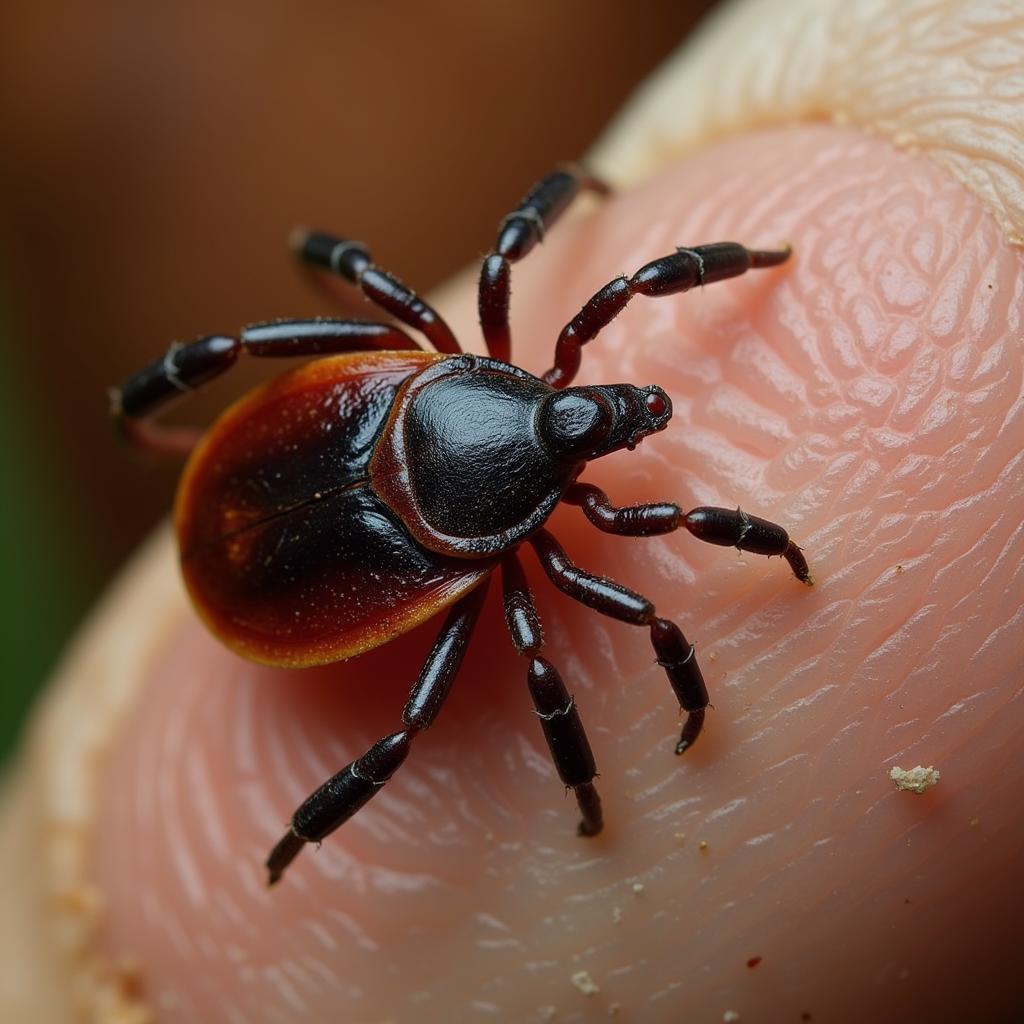Tick bites are a serious concern for horse owners, as they can transmit debilitating diseases that impact your horse’s health and well-being. Implementing effective tick protection is crucial for responsible horse care. This comprehensive guide will equip you with the knowledge and tools to safeguard your equine companion from these tiny but formidable pests.
Understanding the Tick Threat to Horses
Ticks are not insects but rather arachnids closely related to spiders and mites. They thrive in warm, humid environments and are commonly found in grassy, wooded, and brushy areas where horses graze and roam. Ticks are external parasites, meaning they feed on the blood of their hosts to survive.
 Horse Tick Close Up
Horse Tick Close Up
Horses are particularly vulnerable to tick bites due to their size and the amount of time they spend in tick-infested habitats. When a tick bites a horse, it attaches itself to the horse’s skin using its mouthparts and begins feeding on the horse’s blood. This process not only causes irritation and discomfort but also poses a significant health risk.
Tick-Borne Diseases in Horses
Ticks can transmit a variety of diseases to horses, some of which can be life-threatening. These diseases are caused by bacteria, viruses, or protozoa that live in the tick’s saliva and are transmitted to the horse during feeding. Here are some of the most common tick-borne diseases in horses:
-
Lyme disease: Caused by the bacterium Borrelia burgdorferi, Lyme disease can lead to lameness, joint swelling, fever, and lethargy in horses.
-
Anaplasmosis: This disease is caused by the bacterium Anaplasma phagocytophilum and can result in fever, anemia, lethargy, and reluctance to move.
-
Equine piroplasmosis: A protozoal disease spread by ticks, equine piroplasmosis can cause fever, anemia, jaundice, and swelling.
-
Powassan virus: Transmitted by infected ticks, Powassan virus can cause neurological problems in horses, including seizures, paralysis, and death.
Early detection and treatment are essential for improving the chances of a successful recovery from tick-borne diseases. If you observe any unusual symptoms or suspect your horse may have been bitten by a tick, contact your veterinarian immediately.
Types of Tick Protection for Horses
Protecting your horse from ticks requires a multi-pronged approach that includes a combination of preventive measures and proactive tick control strategies. Here’s a breakdown of the most effective methods for tick protection:
1. Tick Repellents
Tick repellents are designed to deter ticks from attaching to your horse in the first place. They are available in various formulations, including sprays, wipes, and spot-on treatments.
-
Permethrin-based repellents: Permethrin is a synthetic insecticide that effectively repels and kills ticks. It is available in sprays and spot-on treatments.
-
DEET-based repellents: DEET (diethyltoluamide) is another effective insect repellent that can be used on horses. However, it is essential to choose products specifically formulated for equine use and follow the instructions carefully.
-
Natural repellents: Some essential oils, such as citronella, lemongrass, and eucalyptus, have tick-repelling properties. While natural repellents can be a good option for horses with sensitive skin, it’s crucial to consult with your veterinarian before using them.
2. Tick Control in the Environment
Creating a tick-unfriendly environment is essential for reducing tick populations and protecting your horse from bites.
-
Regular mowing and landscaping: Keep your pastures and paddocks mowed short to eliminate tick habitats. Trim back bushes and trees to reduce shade and humidity.
-
Fencing: Installing fences can help deter wildlife, such as deer and rodents, that can carry ticks onto your property.
-
Tick tubes: Tick tubes are biodegradable cardboard tubes filled with permethrin-treated cotton. Mice collect the cotton for nesting material, and the permethrin kills ticks on the mice, effectively reducing tick populations.
3. Regular Tick Checks
Despite your best efforts to prevent ticks, regular checks are crucial for identifying and removing any ticks that may have attached to your horse. After riding or spending time in tick-prone areas, thoroughly inspect your horse’s entire body, paying close attention to the following areas:
- Head and ears
- Mane and tail
- Underbelly
- Legs and hooves
- Around the eyes and muzzle
4. Proper Tick Removal
If you find a tick on your horse, it’s crucial to remove it properly to minimize the risk of disease transmission.
- Use fine-tipped tweezers to grasp the tick as close to the skin as possible.
- Pull upward with steady, even pressure. Avoid twisting or jerking the tick, as this can break off the mouthparts and increase the risk of infection.
- Once the tick is removed, clean the bite area with antiseptic and monitor the site for any signs of infection, such as redness, swelling, or discharge.
Conclusion
Protecting your horse from ticks is an ongoing responsibility that requires diligence and a proactive approach. By implementing a comprehensive tick protection strategy that includes repellents, environmental control, regular checks, and proper tick removal techniques, you can significantly reduce your horse’s risk of tick-borne diseases and keep them happy and healthy.
Remember, prevention is key. If you have any questions or concerns about tick protection for your horse, consult with your veterinarian to develop a customized plan tailored to your horse’s individual needs and your local tick population.
Need assistance with tick protection for your equine companion? Contact us! Our team of horse care experts is available 24/7 to provide you with personalized guidance and support.
Phone: 0772127271
Email: [email protected]
Address: QGM2+WX2, Vị Trung, Vị Thuỷ, Hậu Giang, Việt Nam.
We’re here to help you keep your horse safe and healthy.